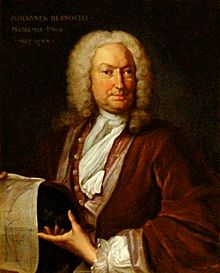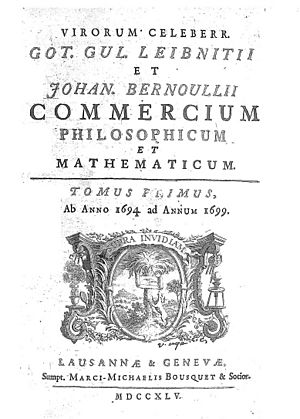Johann Bernoulli facts for kids
Quick facts for kids
Johann Bernoulli
|
|
|---|---|

Johann Bernoulli (portrait by Johann Rudolf Huber, circa 1740)
|
|
| Born | 6 August 1667 Basel, Switzerland
|
| Died | 1 January 1748 (aged 80) Basel, Switzerland
|
| Nationality | Swiss |
| Education | University of Basel (M.D., 1694) |
| Known for | Development of infinitesimal calculus Catenary solution Bernoulli's rule Bernoulli's identity Brachistochrone problem |
| Scientific career | |
| Fields | Mathematics |
| Institutions | University of Groningen University of Basel |
| Thesis | Dissertatio de effervescentia et fermentatione; Dissertatio Inauguralis Physico-Anatomica de Motu Musculorum (On the Mechanics of Effervescence and Fermentation and on the Mechanics of the Movement of the Muscles) (1694 (1690)) |
| Doctoral advisor | Nikolaus Eglinger |
| Other academic advisors | Jacob Bernoulli |
| Doctoral students | Daniel Bernoulli Leonhard Euler Johann Samuel König Pierre Louis Maupertuis |
| Other notable students | Guillaume de l'Hôpital |
| Notes | |
|
Brother of Jacob Bernoulli; the father of Daniel Bernoulli, Nicolaus II Bernoulli, and Johann II Bernoulli; and the uncle of Nicolaus I Bernoulli.
|
|
Johann Bernoulli (also known as Jean or John; 6 August [O.S. 27 July] 1667 – 1 January 1748) was a Swiss mathematician and was one of the many prominent mathematicians in the Bernoulli family. He is known for his contributions to infinitesimal calculus and educating Leonhard Euler in the pupil's youth.
Contents
Biography
Early life
Johann was born in Basel, the son of Nicolaus Bernoulli, an apothecary, and his wife, Margarethe Schongauer, and began studying medicine at University of Basel. His father desired that he study business so that he might take over the family spice trade, but Johann Bernoulli did not like business and convinced his father to allow him to study medicine instead. Johann Bernoulli began studying mathematics on the side with his older brother Jacob Bernoulli. Throughout Johann Bernoulli's education at Basel University the Bernoulli brothers worked together spending much of their time studying the newly discovered infinitesimal calculus. They were among the first mathematicians to not only study and understand calculus but to apply it to various problems. In 1690, he completed a degree dissertation in medicine, reviewed by Leibniz, whose title was De Motu musculorum et de effervescent et fermentation.
Adult life
After graduating from Basel University, Johann Bernoulli moved to teach differential equations. Later, in 1694, he married Dorothea Falkner, the daughter of an alderman of Basel, and soon after accepted a position as the professor of mathematics at the University of Groningen. At the request of his father-in-law, Bernoulli began the voyage back to his home town of Basel in 1705. Just after setting out on the journey he learned of his brother's death to tuberculosis. Bernoulli had planned on becoming the professor of Greek at Basel University upon returning but instead was able to take over as professor of mathematics, his older brother's former position. As a student of Leibniz's calculus, Bernoulli sided with him in 1713 in the Leibniz–Newton debate over who deserved credit for the discovery of calculus. Bernoulli defended Leibniz by showing that he had solved certain problems with his methods that Newton had failed to solve. Bernoulli also promoted Descartes' vortex theory over Newton's theory of gravitation. This ultimately delayed acceptance of Newton's theory in continental Europe.

In 1724, Johann Bernoulli entered a competition sponsored by the French Académie Royale des Sciences, which posed the question:
- What are the laws according to which a perfectly hard body, put into motion, moves another body of the same nature either at rest or in motion, and which it encounters either in a vacuum or in a plenum?
In defending a view previously espoused by Leibniz, he found himself postulating an infinite external force required to make the body elastic by overcoming the infinite internal force making the body hard. In consequence, he was disqualified for the prize, which was won by Maclaurin. However, Bernoulli's paper was subsequently accepted in 1726 when the Académie considered papers regarding elastic bodies, for which the prize was awarded to Pierre Mazière. Bernoulli received an honourable mention in both competitions.
Works
- (in la) De motu musculorum. Venezia. 1721. https://gutenberg.beic.it/webclient/DeliveryManager?pid=12726734.
- (in fr) Recherches physiques et géométriques sur la question comment se fait la propagation de la lumière. Paris. 1736. https://gutenberg.beic.it/webclient/DeliveryManager?pid=13083.
- (in fr) [Opere]. 1. Lausanne. 1742. https://gutenberg.beic.it/webclient/DeliveryManager?pid=1310214.
- (in fr) [Opere]. 2. Lausanne. 1742. https://gutenberg.beic.it/webclient/DeliveryManager?pid=1524873.
- (in fr) [Opere]. 3. Lausanne. 1742. https://gutenberg.beic.it/webclient/DeliveryManager?pid=1311531.
- (in fr) [Opere]. 4. Lausanne. 1742. https://gutenberg.beic.it/webclient/DeliveryManager?pid=1312882.
- Bernoulli, Johann (1786) (in fr). Analyse de l'Opus Palatinum de Rheticus et du Thesaurus mathematicus de Pitiscus. Parigi: sn. https://gutenberg.beic.it/webclient/DeliveryManager?pid=1323305.
- Bernoulli, Johann (1739) (in la). Dissertatio de ancoris. Leipzig: sn. http://atena.beic.it/webclient/DeliveryManager?pid=13462574&search_terms=DTL51.
See also
 In Spanish: Johann Bernoulli para niños
In Spanish: Johann Bernoulli para niños
- Sophomore's dream – a pair of analytical identities by Bernoulli
- Partial fraction decomposition




